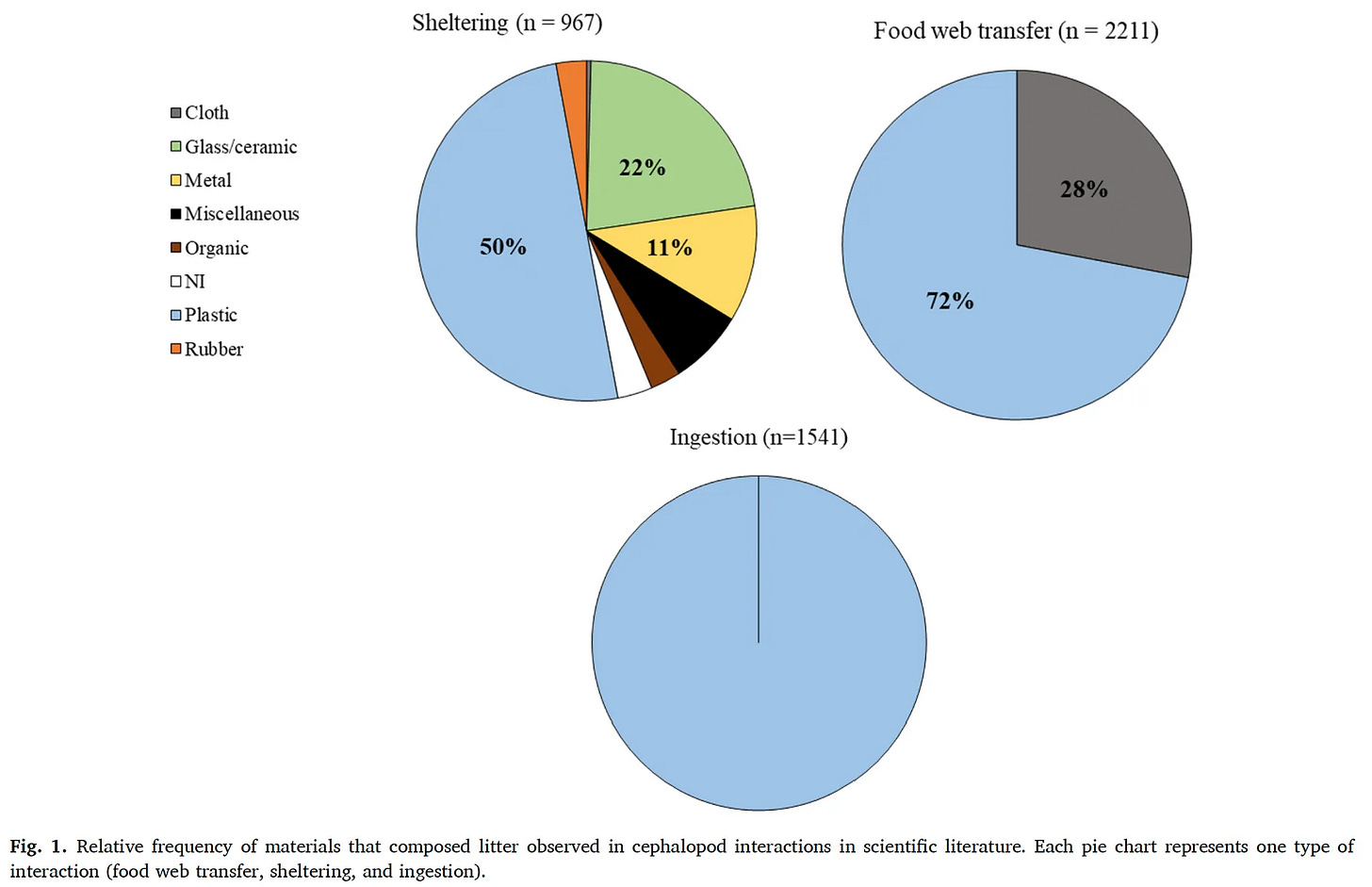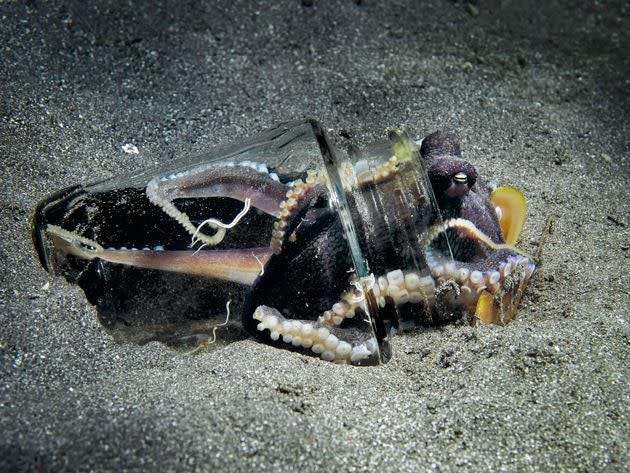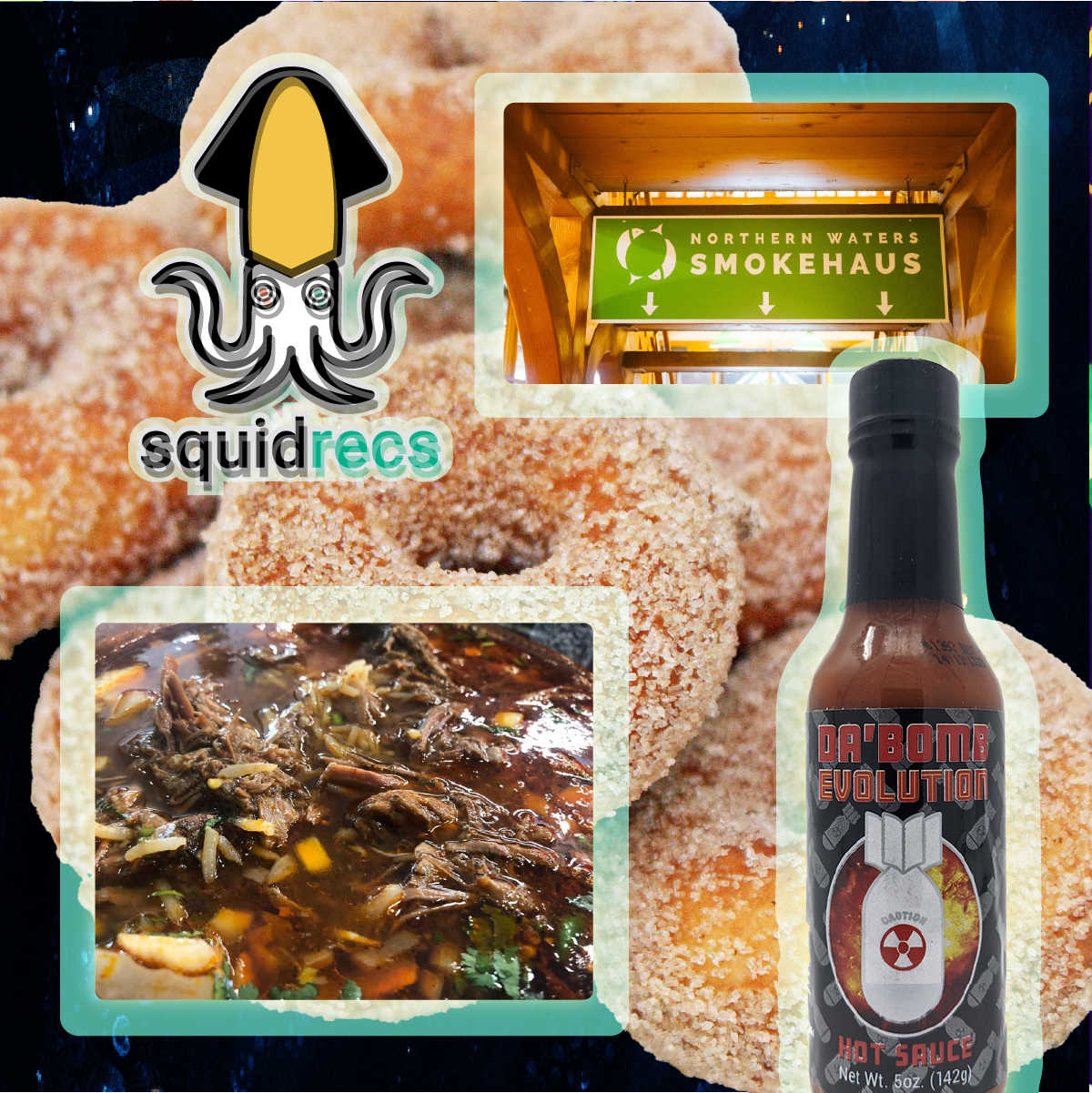Happy solstice for all you alt-cuties out there! Merry Christmas and Happy Chanukah and Happy Gregorian New Year too. This is my gift to you: a holiday-season agnostic squidstack. As always, I value your thoughts, responses, feedback, and, of course, compliments.
In a time where I truly do not know what is happening, one thing I do know is that I use a lot of plastic, some of which now lives deep within my body. Living beautifully: with uncertainty and plastic1 may be the question that defines this generation and generations to come. I’m answering exploring this question in therapy and cephalopods are exploring it in the open ocean, in the coral reefs, and on the seafloor.
As of 2023, 30 studies focus on cephalopods and marine litter.2 These 30 studies suggest cephalopods interacting with trash in 3 ways: eating it (ingestion), eating it and then being eaten (food web transfer), and using it as shelter. Me too, minus the being eaten part!
How do they ingest it? Cephalopods eat marine litter, and indirectly, when cephalopods eat prey that have eaten marine litter or eat prey that are floating amongst marine litter.3 In ingestion studies, scientists catch their cephalopods of interest, open up their gastrointestinal tracts, and take note of what they see. All these studies tracked only microplastics, though it’s likely cephalopods ingest cloth, glass, metal, and other forms of marine litter too. The studies also did not investigate the impacts of microplastic ingestion on cephalopods. Despite this knowledge gap, we wager the effects are negative, as they are on everything from seabirds to mussels, from whales to copepods .
After ingestion comes food web transfer. Food web transfer describes how contaminants move from one trophic level to another. After being ingested, contaminants—like microplastics and the chemicals they contain—can be absorbed into various tissues and cells. When predators eat prey that have absorbed these chemicals, the chemicals are transferred to their predators.
Cephalopods are both predator and prey. They both accumulate toxins from eating contaminant-containing prey and contribute to bioaccumulation in their predators, including us. Humans eat cephalopods and eat fish that eat cephalopods, including skipjack tuna and mahi mahi. When cephalopods eat litter, we eat litter. We are all connected in this beautiful web of life!!!

And lastly, the (possibly) good news! Cephalopods—benthic octopuses in particular—are Living beautifully: with uncertainty and plastic by living in it! They use plastic and other forms of marine litter as shelter. Here is our feel good ecology metaphor about turning lemons into lemonade! In fact, it is so cute that this charming phenomenon makes up 70% of all extant literature on cephalopods and marine litter.
Benthic octopuses live on the exposed seafloor and really, really need shelter—examples include the pygmy octopus (Paroctopus joubini), two spot octopus (Octopus bimaculoides), and ruby octopus (Octopus rubescens). In the past, these octopuses have sheltered in bivalve and gastropod shells (aka seashells). Unfortunately, humans have taken many of these shells to decorate their weird bathrooms or as keepsakes to remember their okay vacations. In their place? Trash!
Benthic octopuses live and conduct key reproductive functions in their trash shelters. The common octopus has been seeing laying its eggs in plastic bins. The European cuttlefish uses squid jigging lures in its egg laying process. Another species of common octopus uses lures to enhance their dens. These guys are creative!
While cephalopods using trash as shelter is inventive and forward thinking, Freitas et al. (2023) does caution that there may unstudied downsides. Eggs lain in plastic may absorb chemicals. Broken glass might hurt octopus’ soft squishy bodies. Well-intentioned environmental clean ups might become catastrophic for trash-sheltering octopuses. Though substituting seashells with plastic bins and beer bottles might have its downsides, it looks like surviving to me! And in 2024, we take what we can get. Soon enough, I’ll be living in a plastic bottle and decorating it with squid lures! Can’t wait for you to join.
Da bomb hot sauce. Painfully spicy. It is said to burn as hot as “the Last Dab,” which is a 2M on the scoville scale. After eating a pinky nail-size amount on a chip, it took me at least 10 minutes, 3 lemon wedges, 2 carrots, and 24 oz of soy milk to regain my ability to speak.
Price-matching. Last month, I bought some items before Black Friday. When sales started popping up, I was bereft. But, after sending a few emails to customer service, I was able to get money back from target (lamps), canopy (overpriced humidifer), and marine layer (jumpsuit w weird pockets). It felt like winning the lottery. Next time you miss a sale at a big box store or venture capital-backed instagram brand, try sending an email! You might get some money back.
Airfrying leftover mini donuts. Good as new, enough said.
Birria Burrito from Cuatro Milpas. Crispy, cheesy, meaty, wet. As you may know, I love wet food, so dipping a juicy burrito into a styrofoam cup of consome was a dream come true!
Northern waters smokehaus! I ate here for 3 meals last weekend. Their smoked fish is juicy and their sandwich bread fluffy. What more could you want? The Cajun Finn—extra pepperoncini—is my favorite, but the new-to-me sandwiches I tried were also good! The Sitka Sushi (nova lox with pickled ginger and wasabi mayo on an italian baguette (stirato)) was actually pretty good for being an asian-inspired monstrosity. The salmon melt (smoked salmon pate and cheddar cheese) was a bit salty but very comforting. I dipped it in sriracha and that added the zhuzh it needed. And to make matters better, at some point in the last 5 years, they moved to a new, more spacious location that features plentiful seating, a separate deli counter, and live music! Next time you pass through Duluth, check it out and bring me back some salmon candy.
Girl media round up
As with clothing, it seems the quality of fluff girl media has declined over the years. Compared to its older sister Sex and the City, Emily in Paris (2020-present) is bad. If it’s a reflection of our times, times are looking grim. The titular girl is a 20-something Midwestern girlboss who bumbles her way through Paris, hooking up with the hottest men and killing the social media marketing game...all while not speaking a word of French. This fantasy for the white everywoman would be better if it was funny or interesting! But before you ask, yes, I did watch all 4 seasons, and I’ll be back for the 5th. I must see what becomes of Gabriel’s hair!
Another Darren Star creation, Sex and the City (1998 - 2004) has held up as an accurate portrayal of dating as a 30-something woman.2 Its timelessness lies in the way Carrie, Miranda, Charlotte, and Samantha dish. When they come together to talk about the different types of people they dated, the weird things people said during sex, or the futures they imagine with people they met once, it’s like a scene out of my own life (or a screenshot out of a group text)!4
When Sex and the City stays in its lane, it is magnificent. But when it strays from that straight, white, wealthy lane and carrie dates a bisexual man, or Samantha interacts with Black Transfemme sex workers, or Charlotte falls into a lesbian friend group—it is unapologetically offensive.
Notably, most episodes feature explicit and implicit fatphobia. While I don’t remember any plainly fatphobic comments in Emily in Paris, I also didn’t see any fat characters. So, at least Sex and the City is honest. Carrie is a terrible friend, and everyone hates their bodies. It’s as simple as that.
Gossip Girl (2007 - 2012) stands apart in this girl media frenzy. It is soap opera magic. Even if you didn’t watch it (or read it) and develop unrealistic expectations for your high school social life, you too will be captivated by the beautiful Serena Van Der Woodsen (Blake Lively), the creepy and pretentious Dan Humphrey (Penn Badgely), and the early 2000s soundtrack (Rhianna, Sean Kingston, Sum 41, etc).
Over the course of the series (90 hours), you’ll meet secret children, fake children, and children who faked their deaths. You find out about secret parents, fake parents, and parents who also faked their deaths. You will be disturbed when someone’s best friend dates all of these secret/fake/dead people at one point or another. Scandals escalate from stealing boyfriends, to step-siblings dating, to student-teacher relationships, to attempted filicide and near patricide.
And of course, Chace Crawford as Nate Archibald is a beautiful himbo! There are live performances by Lady Gaga, Robyn, and St. Vincent. As much as I may criticize the ruling class, I do love a peek into the scandalous lives of Manhattan’s elite. Did you too rewatch gossip girl because it is back on netflix? Drop me a line, tell me what you thought, and let me know that I’m not alone.
You know love you love me, xoxo, squidkid.
sources
Freitas, Tainah B.N., et al. "Understanding the Interactions Between Cephalopods and Marine Litter: A Research Evaluation with Identification of Gaps and Future Perspectives." Marine Pollution Bulletin, vol. 190, 2023, 114814, ISSN 0025-326X, https://doi.org/10.1016/j.marpolbul.2023.114814.
Capillo, Gioele et al. “Evidence of uses of marine litter by Mediterranean Cephalopoda.” Frontiers in Marine Science, vol. 11, 2024, article 1519412, https://doi.org/10.3389/fmars.2024.1519412.
Peng, Licheng et al. “Micro- and nano-plastics in marine environment: Source, distribution and threats — A review.” Science of The Total Environment, vol. 698, 2020, 134254, ISSN 0048-9697, https://doi.org/10.1016/j.scitotenv.2019.134254.
Living Beautifully: with Uncertainty and Change by Pema Chödrön has been on my shelf for years. “Pema Chodron teaches, that kind of fear-based clinging keeps us from the infinitely more satisfying experience of being fully alive.”
Why the dearth of research? Freitas, et al. (2023) suggests invertebrates are understudied in general—perhaps due to their small size and “often cryptic behavior.” Vertebrate bias abounds!
Interestingly/alarmingly even seawater aquaculture cuttlefish (Sepia officinalis) contain microplastics. They contain fewer microplastics than wild-caught cuttlefish…but that plastic still gets in there!
It might resonate because many of the people I’m around are (or were) high-achieving, highly anxious Mirandas. Cynthia Nixon is, after all, a lesbian.










